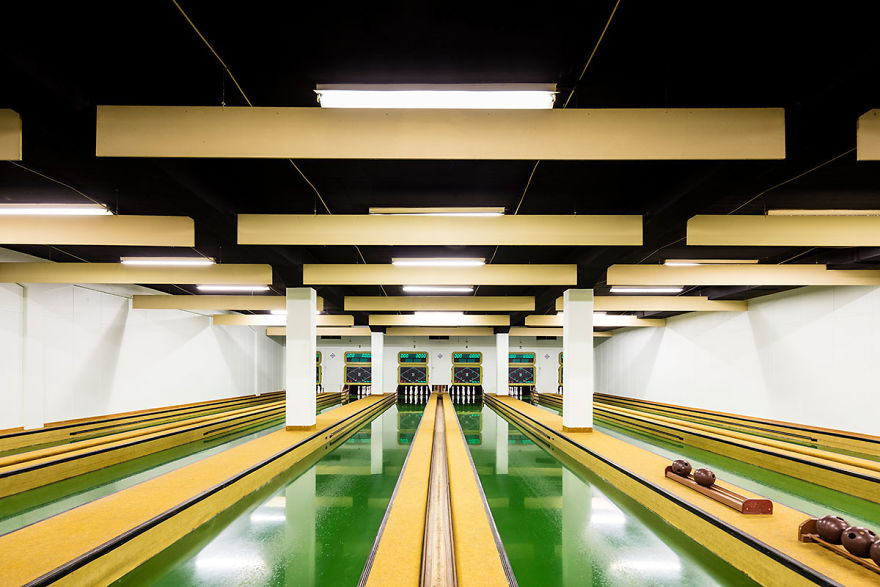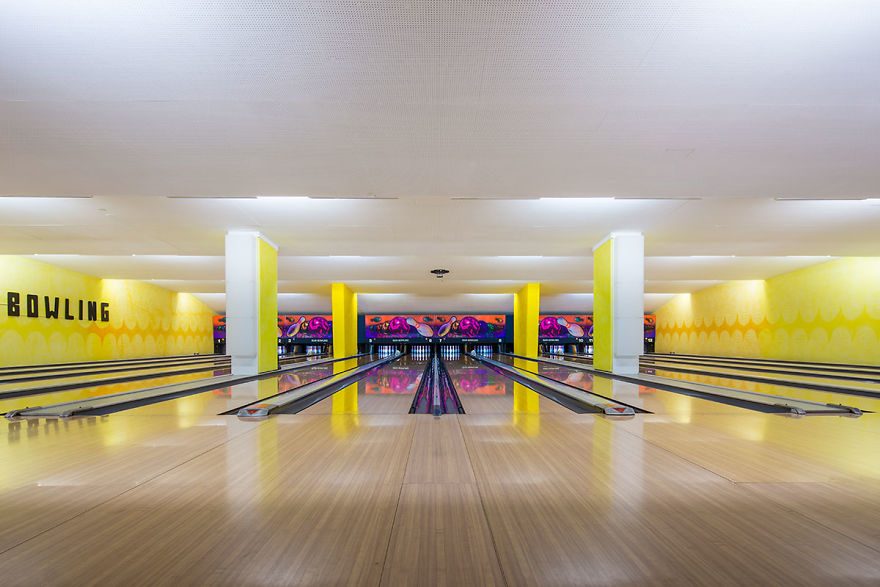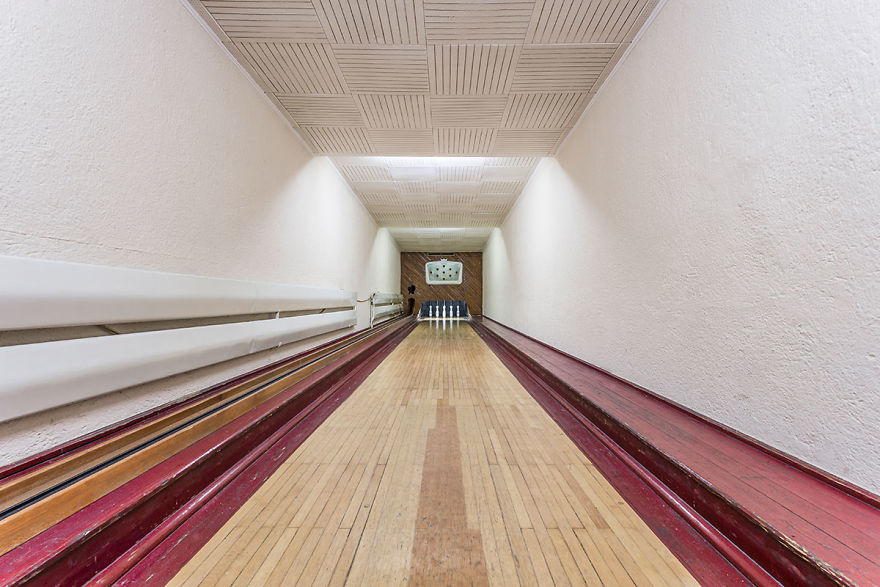It all started out with a photo job I did a couple of years ago because this building had a bowling alley, or a "Kegelbahn" how a similar sport is called in Germany. Kegeln is pretty close to bowling but with only nine pins, smaller balls, and shorter lanes. It used to be a big thing in Germany in the 60's, 70's and 80's. These days this sport is not en vogue anymore and it seems that mostly older people go these "Kegelbahnen".
Me and my family and friends used to go "Kegeln" back when I was a kid. So that job was kind of a throw back for me and hit me straight in the heart because it was linked to so many great memories.
That's why I started to create another photo series that goes pretty well along with my other work - I'm a big fan of the central perspective, of lines, and, patterns.
It's been a couple of years now that I've been trying to find the most exciting bowling alleys and "Kegelbahnen" in Southern Germany. I usually just call the places, and if they agree that I take some shots I simply grab my equipment, jump on the motorbike and go for it.
I hope you like it.
More info: robert-goetzfried.com
This post may include affiliate links.
It's in the basement of a restaurant. I don't know why they put this stuff there but no one ever sat there.
Hi Alia, I actually shot a photo series of pools. You can check them out on my website.
Load More Replies...These are nice photos. They bring back memories of a company I worked for in Southern Germany in '81. There was a one-lane kegelbahn in the basement for the employees to hang out after work. Nice benefit! (That and the cases of beer they kept in the stairwells.)
All these bowling alleys makes me want to move to Germany even though I'm not a bowler
If you look closely at the photos of the 9-pin lanes, you will see a string attached to the tops of the pins. The mechanism reset the pins by pulling up on the strings. Sometimes the strings got tangled up, so the mechanism would drop them all and try again. Once in a while, you had to walk down to the end and untangle them. A few of the photos appear to be of the 10-pin "American Bowling", which use the resetting mechanism common in the USA, where the pins are loose, get gathered up, and cycled back into place.
9-pin bowling used to be illegal in most of the US (it supposedly led to gambling) but still exists in areas that were settled by German immigrants in the 19th c. like New Braunfels, Texas and along the Iowa-Nebraska border. Here's a CBS News clip about the alley in New Braunfels: https://www.youtube.com/watch?v=Qp9212NbnXM
Thanks for sharing this link! I didn't know that story. Interesting to see that 9-pin has a tradition in the US.
Load More Replies...They're mystical I like them but does it strike anyone else that the bowling alleys are all so small? There's hardly any with more than 5 lanes. Are bowling alleys just smaller there?
Since most bowling alleys in the US were built in the open suburbs space was rarely a consideration. Most were in shopping centers and all had even bigger parking lots. Our city bowling alleys were generally much smaller, though still bigger than these kegelbahns.
Load More Replies...Why do all the lanes have one end that is wider than the other end?
I mostly used a Canon TS-E 17mm Tilt-Shift lens. Some of them were shot with a Canon 16-35mm lens.
Load More Replies...Love the creativity behind all of them and what they represent. But some of them makes me feel a bit claustrophobic regardless the idea and creativity behind it.
Well, you cared enough to comment so, obviously you care!! YAAAY YOU!!
Load More Replies...These are nice photos. They bring back memories of a company I worked for in Southern Germany in '81. There was a one-lane kegelbahn in the basement for the employees to hang out after work. Nice benefit! (That and the cases of beer they kept in the stairwells.)
All these bowling alleys makes me want to move to Germany even though I'm not a bowler
If you look closely at the photos of the 9-pin lanes, you will see a string attached to the tops of the pins. The mechanism reset the pins by pulling up on the strings. Sometimes the strings got tangled up, so the mechanism would drop them all and try again. Once in a while, you had to walk down to the end and untangle them. A few of the photos appear to be of the 10-pin "American Bowling", which use the resetting mechanism common in the USA, where the pins are loose, get gathered up, and cycled back into place.
9-pin bowling used to be illegal in most of the US (it supposedly led to gambling) but still exists in areas that were settled by German immigrants in the 19th c. like New Braunfels, Texas and along the Iowa-Nebraska border. Here's a CBS News clip about the alley in New Braunfels: https://www.youtube.com/watch?v=Qp9212NbnXM
Thanks for sharing this link! I didn't know that story. Interesting to see that 9-pin has a tradition in the US.
Load More Replies...They're mystical I like them but does it strike anyone else that the bowling alleys are all so small? There's hardly any with more than 5 lanes. Are bowling alleys just smaller there?
Since most bowling alleys in the US were built in the open suburbs space was rarely a consideration. Most were in shopping centers and all had even bigger parking lots. Our city bowling alleys were generally much smaller, though still bigger than these kegelbahns.
Load More Replies...Why do all the lanes have one end that is wider than the other end?
I mostly used a Canon TS-E 17mm Tilt-Shift lens. Some of them were shot with a Canon 16-35mm lens.
Load More Replies...Love the creativity behind all of them and what they represent. But some of them makes me feel a bit claustrophobic regardless the idea and creativity behind it.
Well, you cared enough to comment so, obviously you care!! YAAAY YOU!!
Load More Replies...
 Dark Mode
Dark Mode 

 No fees, cancel anytime
No fees, cancel anytime 
















































































